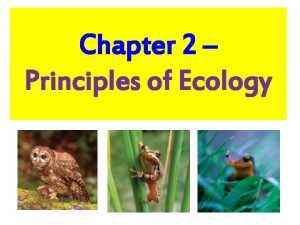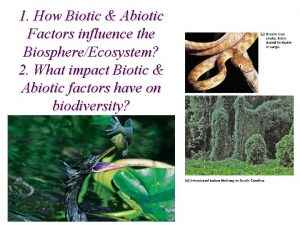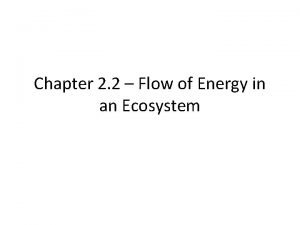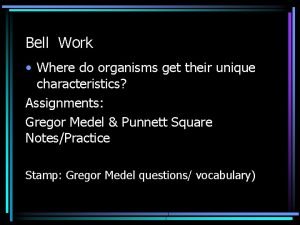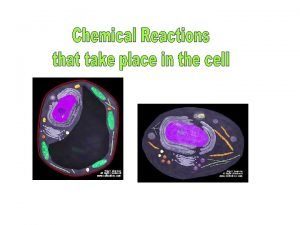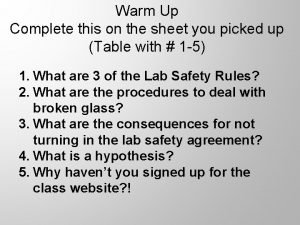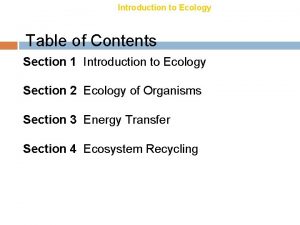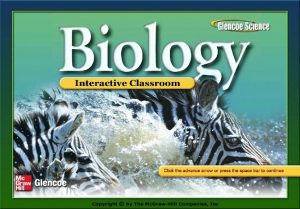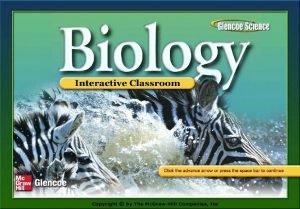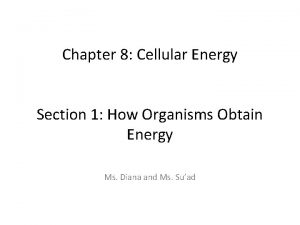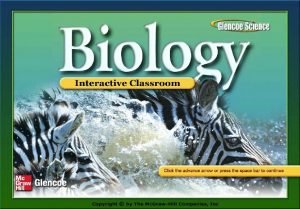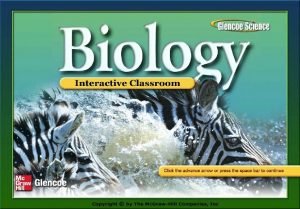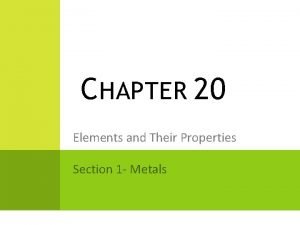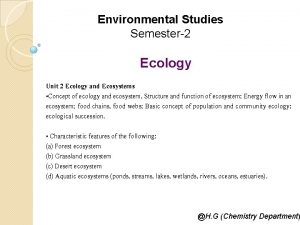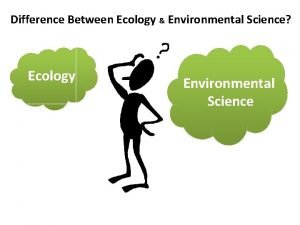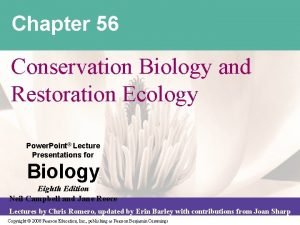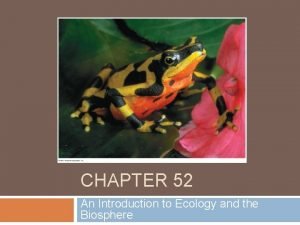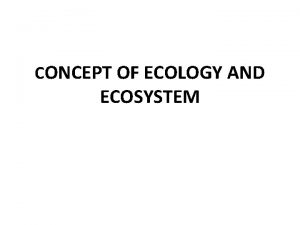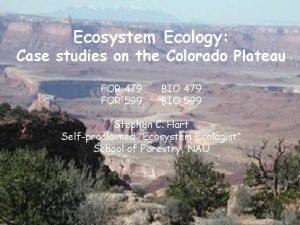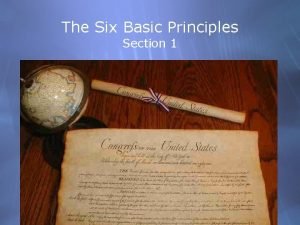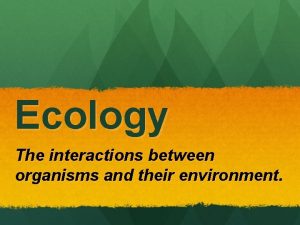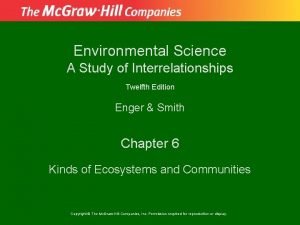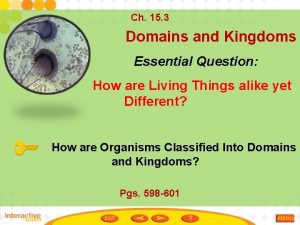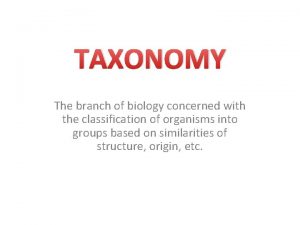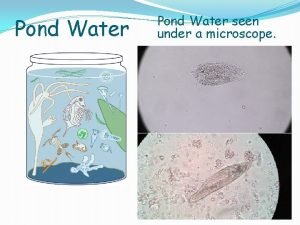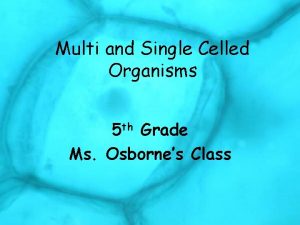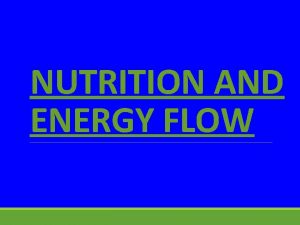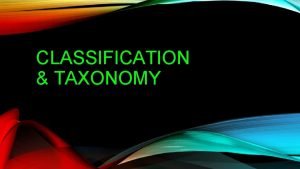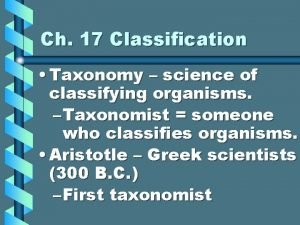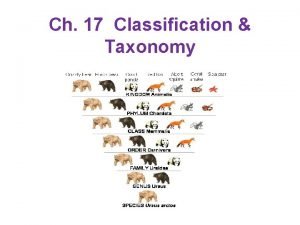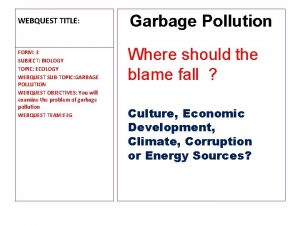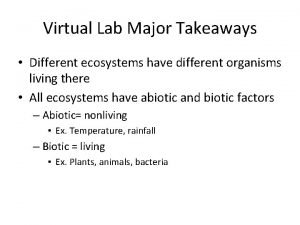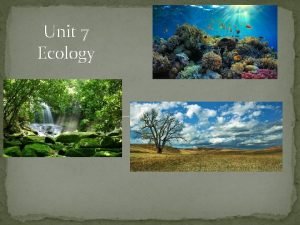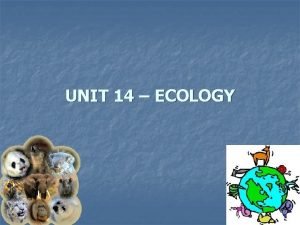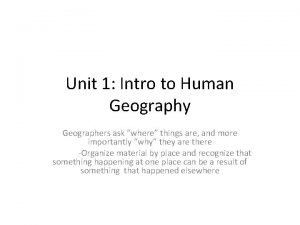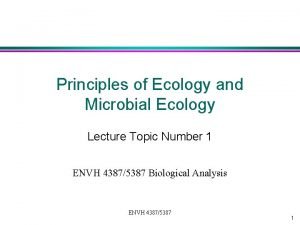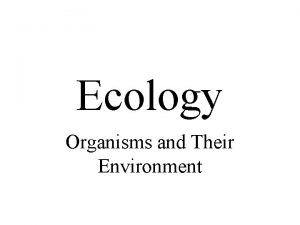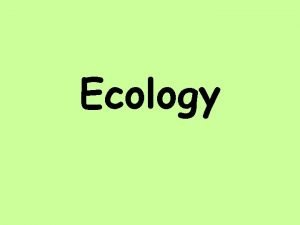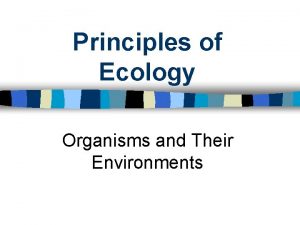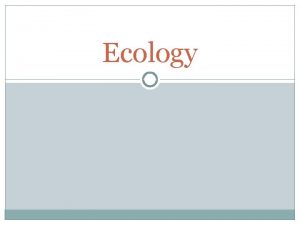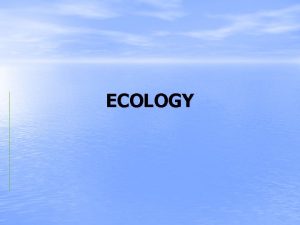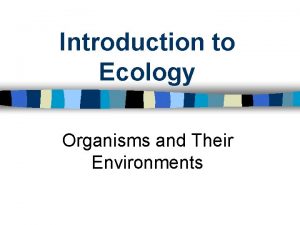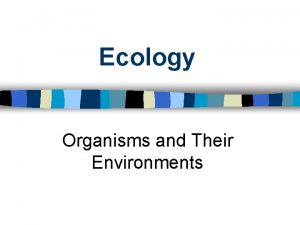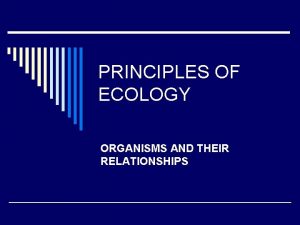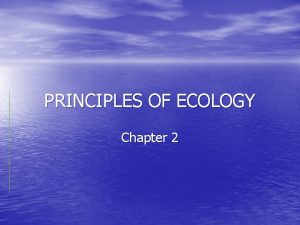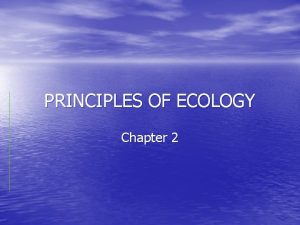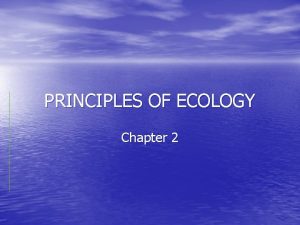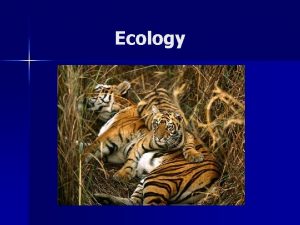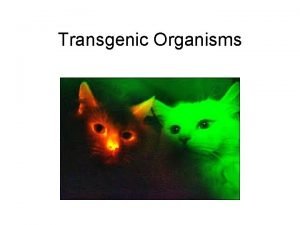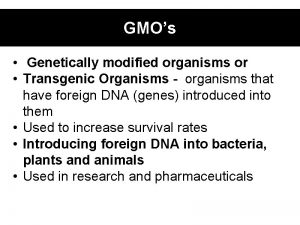Principles of Ecology Section 1 Organisms and Their











































































- Slides: 75


Principles of Ecology Section 1: Organisms and Their Relationships Section 2: Flow of Energy in an Ecosystem Section 3: Cycling of Matter Click on a lesson name to select.

Section 1 Principles of Ecology Organisms and Their Relationships Ecology § Scientific discipline in which the relationships among living organisms and the interaction the organisms have with their environments are studied § Ecologists observe, experiment, and model using a variety of tools and methods.

Section 1 Principles of Ecology Organisms and Their Relationships The Biosphere § A thin layer around Earth that supports life § Extends several kilometers above the Earth’s surface § Extends several kilometers below the ocean’s surface

Section 1 Principles of Ecology Organisms and Their Relationships The Biosphere

Section 1 Principles of Ecology Organisms and Their Relationships Biotic Factors § Living factors in an organism’s environment Abiotic Factors § Nonliving factors in an organism’s environment § Organisms adapt to survive in the abiotic factors present in their natural environment.

Section 1 Principles of Ecology Organisms and Their Relationships Levels of Organization-Amoeba Sisters: Biological Levels § Levels increase in complexity as the numbers and interactions between organisms increase. § organism § population § biological community § ecosystem § biome § biosphere

Section 1 Principles of Ecology Organisms and Their Relationships § The lowest level of organization is the individual organism itself. § Organisms of a single species that share the same geographic location at the same time make up a population. § A biological community is a group of interacting populations that occupy the same geographic area at the same time.

Section 1 Principles of Ecology Organisms and Their Relationships § An ecosystem is a biological community and all of the abiotic factors that affect it. § A biome is a large group of ecosystems that share the same climate and have similar types of communities.

Section 1 Principles of Ecology Organisms and Their Relationships Ecosystem Interactions § A habitat is an area where an organism lives. § A niche is the role or position that an organism has in its environment.

In your notebook…. Divide a whole page into 4 sections Biosphere Ecosystem Community Population Habitat and Niche

For each square on your chart include: • • Description: Picture: Examples: (see next slide) Contains Abiotic and/or Biotic factors?

Examples-add to your chart where they fit the best • • • A herd of bison Frogs, insects, and birds living near a pond Plants, animals, water and soil of a forest The kelp forest where sea otters live All the hummingbirds that live in your state A freshwater stream where mussels grow Fish, eels, and lobsters living on a coral reef The ocean A dying tree with holes that animals live in Wetland plants, animals, and marshes

Section 1 Principles of Ecology Organisms and Their Relationships Community Interactions § Competition § Occurs when more than one organism uses a resource at the same time § Predation § Many species get their food by eating other organisms.

Section 1 Principles of Ecology Organisms and Their Relationships Symbiotic Relationships § The close relationship that exists when two or more species live together As you watch the video, write a description of the 3 main types of symbiosis Untamed Science Symbiosis § Mutualism § Commensalism § Parasitism

Good Buddies Game while you play the game, record the relationships in the correct column. Use to show if an organism is helped, if an organism is harmed, if it is not affected Commensalism Mutualism Parasitism Ex) flea , dog

Section 2 Principles of Ecology Flow of Energy in an Ecosystem § Autotrophs § Organisms that collect energy from sunlight or inorganic substances to produce food. § Heterotrophs § Organisms that get their energy requirements by consuming other organisms.

Section 2 Principles of Ecology Flow of Energy in an Ecosystem § Detritivores are organisms that eat fragments of dead matter in an ecosystem, and return nutrients to the soil, air, and water where the nutrients can be reused by organisms. § Watch the Brain POP: Food Chains § Cool Classroom demo: http: //coolclassroom. org/cool_windows/home. ht ml

Section 2 Principles of Ecology Flow of Energy in an Ecosystem Models of Energy Flow § Food chains and food webs model the energy flow through an ecosystem. § Each step in a food chain or food web is called a trophic level. Model Ecosystems

Section 2 Principles of Ecology Flow of Energy in an Ecosystem Food Chains § A food chain is a simple model that shows how energy flows through an ecosystem.

Section 2 Principles of Ecology Flow of Energy in an Ecosystem Food Webs § A food web is a model representing the many interconnected food chains and pathways in which energy flows through a group of organisms.

Identify: • • • Producers: Primary Consumers Secondary consumers Tertiary Consumers Quaternary (Top) Consumer

Section 2 Principles of Ecology Flow of Energy in an Ecosystem-Watch the BP: Energy Pyramids Ecological Pyramids § A diagram that can show the relative amounts of energy, biomass, or numbers of organisms at each trophic level in an organism

Energy Pyramids • Draw an energy pyramid for the food web you constructed in your notebook

Section 3 Principles of Ecology Cycling of Matter Cycles in the Biosphere § The cycling of nutrients in the biosphere involves both matter in living organisms and physical processes found in the environment such as weathering.

Section 3 Principles of Ecology Cycling of Matter The Water Cycle

Section 3 Principles of Ecology Cycling of Matter-the Water Cycle-watch the Brain POP on water cycle and add the diagram and notes to your EOC notebook Sources of water: oceans, clouds, lakes, plants, animals, rivers, groundwater Processes: Evaporation- liquid to a gas (involves heat) Condensation-gas to liquid Transpiration-evaporation from plants Infiltration- water soaks into rock/soil Precipitation-rain/snow/sleet, etc

Section 3 Principles of Ecology Cycling of Matter-Carbon/Oxygen Cycle-watch the Brain POP on Carbon Cycle and add the diagram and notes to your EOC notebook

Carbon Cycle Sources: animals, respiration, burning fossil fuels, decaying of plants/animals, ocean (carbon sink) Uses: plants use carbon dioxide in photosynthesis Processes: combustion, respiration, photosynthesis, diffusion, deposition

Section 3 Principles of Ecology Cycling of Matter § Carbon and oxygen often make up molecules essential for life. § Carbon and oxygen recycle relatively quickly through living organisms.

Section 3 Principles of Ecology Cycling of Matter Long-term Cycle § Organic matter converted to peat, coal, oil, or gas deposits (carbon) § Calcium carbonate (carbon and oxygen)released during weathering of rock Short-term Cycle § Burning fossil fuels (carbon)

Section 3 Principles of Ecology Cycling of Matter The Nitrogen Cycle § The capture and conversion of nitrogen into a form that is useable by plants is called nitrogen fixation.

Section 3 Principles of Ecology

Section 3 Principles of Ecology Cycling of Matter § Nitrogen enters the food web when plants absorb nitrogen compounds from soil. § Consumers get nitrogen by eating plants or animals that contain nitrogen.

Section 3 Principles of Ecology Cycling of Matter § Nitrogen is returned to the soil in several ways: § Animals urinate. § Organisms die. § Organisms convert ammonia into nitrogen compounds. § Denitrification

Section 3 Principles of Ecology Cycling of Matter The Phosphorus Cycle

Section 3 Principles of Ecology

Section 3 Principles of Ecology Cycling of Matter Short-term Cycle § Phosphorus is cycled from the soil to producers and then from the producers to consumers. Long-term Cycle § Weathering or erosion of rocks that contain phosphorus slowly adds phosphorus to the cycle.

Chapter Principles of Ecology Chapter Resource Menu Chapter Diagnostic Questions Formative Test Questions Chapter Assessment Questions Standardized Test Practice connected. mcgraw-hill. com Glencoe Biology Transparencies Image Bank Vocabulary Animation Click on a hyperlink to view the corresponding feature.

Chapter Principles of Ecology Chapter Diagnostic Questions The act of one organism consuming another organism for food is _______. A. predation B. parasitism C. commensalism D. mutualism 1. 2. 3. 4. A B C D

Chapter Principles of Ecology Chapter Diagnostic Questions Identify how energy flows through an ecosystem in a typical food chain. A. from an autotroph to a heterotroph B. from a heterotroph to an autotroph C. from a carnivore to an herbivore D. from an omnivore to an herbivore 1. 2. 3. 4. A B C D

Chapter Principles of Ecology Chapter Diagnostic Questions What is a chemical substance that an organism must obtain from its environment to survive? A. biomass B. energy C. matter D. nutrient 1. 2. 3. 4. A B C D

Chapter Principles of Ecology Section 1 Formative Questions Which are biotic factors in a forest environment? A. plants and microscopic living organisms B. p. H and salt concentration of the soil C. sunlight, soil type and soil nutrients D. temperature, air currents and rainfall 1. 2. 3. 4. A B C D

Chapter Principles of Ecology Section 1 Formative Questions What is the name for a group of interacting populations that occupy the same area at the same time? A. ecosystem B. habitat C. biological community D. biotic collection 1. 2. 3. 4. A B C D

Chapter Principles of Ecology Section 1 Formative Questions Which defines habitat? A. all of the biotic factors in an ecosystem B. an area where an organism lives C. an area in which various species interact D. the role or position that an organism has 1. 2. 3. 4. A B C D

Chapter Principles of Ecology Section 2 Formative Questions What type of organism is the foundation of all ecosystems? A. autotroph B. herbivore C. heterotroph D. decomposer 1. 2. 3. 4. A B C D

Chapter Principles of Ecology Section 2 Formative Questions How do detritivores obtain their energy in an ecosystem? A. They feed on fragments of dead plants and animals B. They feed on organisms by releasing digestive enzymes. C. They get energy from inorganic substances to make food. D. They use chlorophyll to capture energy from the sun.

Chapter Principles of Ecology Section 2 Formative Questions Which type of organism exists at all trophic levels except the first trophic level? A. carnivores B. herbivores C. autotrophs D. heterotrophs 1. 2. 3. 4. A B C D

Chapter Principles of Ecology Section 3 Formative Questions What type of organism returns nutrients to an ecosystem? A. decomposer B. primary producer C. secondary producer D. top level consumer 1. 2. 3. 4. A B C D

Chapter Principles of Ecology Section 3 Formative Questions What type of scientist studies water found underground, in the atmosphere, and on the surface of the earth? A. biochemist B. ecologist C. geologist D. hydrologist 1. 2. 3. 4. A B C D

Chapter Principles of Ecology Section 3 Formative Questions Which biogeochemical cycle involves evaporation, transpiration, precipitation and runoff? A. carbon cycle B. nitrogen cycle C. phosphorus cycle D. water cycle 1. 2. 3. 4. A B C D

Chapter Principles of Ecology Section 3 Formative Questions Which process in this cycle converts carbon dioxide and water into carbohydrates? A. photosynthesis B. respiration C. combustion of fossil fuels D. deposition of dead material 1. 2. 3. 4. A B C D

Chapter Principles of Ecology Chapter Assessment Questions Use the diagram to compare and contrast biotic and abiotic factors. Give examples of each.

Chapter Principles of Ecology Chapter Assessment Questions Answer: Biotic factors include the living factors in an organism’s environment, such as animals, plants, and microscopic organisms. Abiotic factors are the nonliving factors, such as water temperature, p. H, rainfall, soil, and available nutrients.

Chapter Principles of Ecology Chapter Assessment Questions Use the image below to explain how decomposers supply phosphorus to soil, groundwater, oceans, lakes, ponds, and rivers.

Chapter Principles of Ecology Chapter Assessment Questions Answer: All organisms contain phosphorus. When organisms die or produce waste products, decomposers return the phosphorus to the soil where it can be used again.

Chapter Principles of Ecology Chapter Assessment Questions The diagram shows how carbon cycles through the environment. Describe how photosynthesis is involved in the carbon cycle.

Chapter Principles of Ecology Chapter Assessment Questions Answer: During photosynthesis, green plants and algae convert carbon dioxide and water to carbohydrates and release oxygen into the air. The plants use the carbohydrates to store energy. Carbon dioxide is released back into the air through cellular respiration.

Chapter Principles of Ecology Standardized Test Practice In what type of activity would you most expect an ecologist to be involved? A. identifying and classifying various species of insects in an ecosystem B. locating fossils of distinct species of turtles in a geographical area C. observing the relationships that woodpeckers have with other species in their environment D. studying the internal organs of a seal to learn how it survives in its environment 1. 2. 3. 4. A B C D

Chapter Principles of Ecology Standardized Test Practice Certain types of tropical orchids use trees for support in order to grow higher and obtain more light. This neither harms nor benefits the tree. What type of symbiotic relationship is this? A. commensalism B. competition C. mutualism D. parasitism 1. 2. 3. 4. A B C D

Chapter Principles of Ecology Standardized Test Practice If an ecologist finds that the long-tailed weasels have disappeared from the desert community, she should conclude that there will be a decrease in the population of coyotes. A. true B. false 1. 2. A B

Chapter Principles of Ecology Standardized Test Practice Why is this mouse classified as an omnivore? A. It consumes grasshoppers. B. It is consumed by snakes. C. It consumes both grasshoppers and plants. D. It is a third-level consumer. 1. 2. 3. 4. A B C D

Chapter Principles of Ecology Standardized Test Practice Which process returns nitrogen to the food web? A. decomposition B. denitrification C. nitrification D. nitrogen fixation 1. 2. 3. 4. A B C D

Chapter Principles of Ecology Glencoe Biology Transparencies

Chapter Principles of Ecology Image Bank

Section 1 Principles of Ecology Vocabulary Section 1 ecology habitat biosphere biotic factor abiotic factor population biological community ecosystem niche predation symbiosis mutualism commensalism parasitism biome

Section 2 Principles of Ecology Vocabulary Section 2 autotroph food chain heterotroph herbivore carnivore omnivore detritivore trophic level food web biomass

Section 3 Principles of Ecology Vocabulary Section 3 matter nutrient biogeochemical cycle nitrogen fixation denitrification

Chapter Principles of Ecology Animation Visualizing Levels of Organization Desert Community Food Web The Water Cycle The Carbon Cycle The Nitrogen Cycle The Phosphorus Cycle

Chapter Principles of Ecology

Chapter Principles of Ecology

Chapter Principles of Ecology

Chapter Principles of Ecology

Chapter Principles of Ecology

Chapter Principles of Ecology
 Principles of ecology chapter 2 section 2 answer key
Principles of ecology chapter 2 section 2 answer key Principles of ecology organisms and their relationships
Principles of ecology organisms and their relationships Principles of ecology section 3 cycling of matter
Principles of ecology section 3 cycling of matter Principles of ecology chapter 2 section 1 answer key
Principles of ecology chapter 2 section 1 answer key Chapter 2 section 1 organisms and their relationships
Chapter 2 section 1 organisms and their relationships Chapter 2 section 1 organisms and their relationships
Chapter 2 section 1 organisms and their relationships Unicellular and multicellular
Unicellular and multicellular Levels of organization in the biosphere
Levels of organization in the biosphere Why do organisms interact with other organisms
Why do organisms interact with other organisms Living organisms and their surroundings
Living organisms and their surroundings Principles of ecology 2 flow of energy in an ecosystem
Principles of ecology 2 flow of energy in an ecosystem Where do organisms get their traits?
Where do organisms get their traits? Where do all organisms get their energy
Where do all organisms get their energy The process of grouping things based on their similarities
The process of grouping things based on their similarities Organisms that make their own food
Organisms that make their own food Chapter 3 section 1: community ecology answer key
Chapter 3 section 1: community ecology answer key Chapter test a chapter 4 population ecology answer key
Chapter test a chapter 4 population ecology answer key Section 18-1 introduction to ecology worksheet answers
Section 18-1 introduction to ecology worksheet answers Population ecology section 1 population dynamics
Population ecology section 1 population dynamics Population ecology section 1 population dynamics
Population ecology section 1 population dynamics Chapter 4 section 1 population dynamics study guide answers
Chapter 4 section 1 population dynamics study guide answers Section 1 how organisms obtain energy
Section 1 how organisms obtain energy Chapter 8 section 1 how organisms obtain energy answer key
Chapter 8 section 1 how organisms obtain energy answer key Chapter 8 section 1 how organisms obtain energy
Chapter 8 section 1 how organisms obtain energy Chapter 8 section 1 how organisms obtain energy
Chapter 8 section 1 how organisms obtain energy Chapter 26 section 2 arthropod diversity
Chapter 26 section 2 arthropod diversity Chapter 17 elements and their properties answer key
Chapter 17 elements and their properties answer key Elements and their properties section 1 metals
Elements and their properties section 1 metals Chapter 17 overview elements and their properties
Chapter 17 overview elements and their properties The prologue of romeo and juliet in modern english
The prologue of romeo and juliet in modern english Mind map about media and information literacy
Mind map about media and information literacy Chapter 52 an introduction to ecology and the biosphere
Chapter 52 an introduction to ecology and the biosphere Difference between ecosystem and ecology
Difference between ecosystem and ecology Ecology and environmental science
Ecology and environmental science Chapter 56 conservation biology and restoration ecology
Chapter 56 conservation biology and restoration ecology Chapter 55 ecosystems and restoration ecology
Chapter 55 ecosystems and restoration ecology Chaparral climograph
Chaparral climograph Chapter 5 evolution and community ecology
Chapter 5 evolution and community ecology Difference between ecosystem and ecology
Difference between ecosystem and ecology Chapter 55 ecosystems and restoration ecology
Chapter 55 ecosystems and restoration ecology Chapter 5 evolution and community ecology
Chapter 5 evolution and community ecology Chapter 5 evolution and community ecology answer key
Chapter 5 evolution and community ecology answer key Ecosystem ecology
Ecosystem ecology Chapter 1 science and the environment
Chapter 1 science and the environment Example of cutting plane line
Example of cutting plane line Work and energy section 2 describing energy answer key
Work and energy section 2 describing energy answer key Section 1 the six basic principles
Section 1 the six basic principles Kingdom phylum class order
Kingdom phylum class order Blue things
Blue things Organisms and the environment
Organisms and the environment Multicellular organism meaning
Multicellular organism meaning Zones in lake ecosystem and types of organisms present
Zones in lake ecosystem and types of organisms present How are organisms classified into domains and kingdoms
How are organisms classified into domains and kingdoms Dichotomous key
Dichotomous key How are unicellular and multicellular organisms alike
How are unicellular and multicellular organisms alike Homo taxonomy
Homo taxonomy Organism
Organism Unicellular organisms
Unicellular organisms Single celled life form
Single celled life form This is the study of grouping and naming organisms
This is the study of grouping and naming organisms The scientific discipline of classifying organisms
The scientific discipline of classifying organisms How organisms obtain energy
How organisms obtain energy Discipline of classifying and naming organisms
Discipline of classifying and naming organisms The science of naming and classifying organisms
The science of naming and classifying organisms Kingdom phylum class order
Kingdom phylum class order Discipline of classifying and naming organisms
Discipline of classifying and naming organisms Discipline of classifying and naming organisms
Discipline of classifying and naming organisms Ecology webquest answers
Ecology webquest answers Food chain virtual lab
Food chain virtual lab Unit 7 ecology answer key
Unit 7 ecology answer key Biotic community is another name for____
Biotic community is another name for____ Distortion
Distortion Sustainability definition ap human geography
Sustainability definition ap human geography Ernst haeckel ecology
Ernst haeckel ecology Stable community
Stable community What is niche in biology
What is niche in biology





